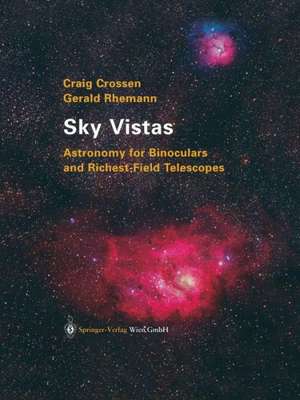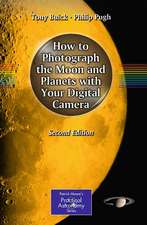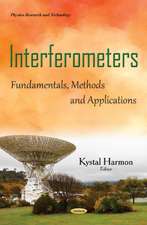Sky Vistas: Astronomy for Binoculars and Richest-Field Telescopes
Autor Craig Crossen, Gerald Rhemannen Limba Engleză Paperback – 22 aug 2014
Astronomy
"This is a practical and stunningly beautiful guide whose core is a descriptive tour of the best celestial sights: open and globular clusters, nebulae, galaxies, and large areas of sky. The photos in black and white and color, are magnificent. The text goes beyond ordinary descriptions to tell the reader something about each object’s nature."
Sky & Telescope
"Packed with information that I have encountered nowhere else in amateur-astronomy literature. Sky Vistas also includes 48 full-page color astrophotos by Gerald Rhemann, most of which are magnificent."
| Toate formatele și edițiile | Preț | Express |
|---|---|---|
| Paperback (1) | 957.75 lei 6-8 săpt. | |
| SPRINGER VIENNA – 22 aug 2014 | 957.75 lei 6-8 săpt. | |
| Hardback (1) | 856.17 lei 38-44 zile | |
| SPRINGER VIENNA – 19 noi 2003 | 856.17 lei 38-44 zile |
Preț: 957.75 lei
Preț vechi: 1167.99 lei
-18% Nou
Puncte Express: 1437
Preț estimativ în valută:
183.29€ • 189.09$ • 155.13£
183.29€ • 189.09$ • 155.13£
Carte tipărită la comandă
Livrare economică 04-18 martie
Preluare comenzi: 021 569.72.76
Specificații
ISBN-13: 9783709172131
ISBN-10: 3709172136
Pagini: 356
Ilustrații: XVII, 286 p. 121 illus., 48 illus. in color. With 48 color plates.
Dimensiuni: 210 x 279 x 24 mm
Greutate: 0.8 kg
Ediția:Softcover reprint of the original 1st ed. 2004
Editura: SPRINGER VIENNA
Colecția Springer
Locul publicării:Vienna, Austria
ISBN-10: 3709172136
Pagini: 356
Ilustrații: XVII, 286 p. 121 illus., 48 illus. in color. With 48 color plates.
Dimensiuni: 210 x 279 x 24 mm
Greutate: 0.8 kg
Ediția:Softcover reprint of the original 1st ed. 2004
Editura: SPRINGER VIENNA
Colecția Springer
Locul publicării:Vienna, Austria
Public țintă
Popular/generalDescriere
galactic perspective." Much of the pleasure of Sky Vistas is an astronomy guidebook for both astronomical observing comes from "looking" with active and "armchair" observers. First, it is a practical observing guide to the deep-sky objects the mind as well as the eye. Thus Sky Vistas describes how the naked-eye appearance of the that are visible in low-power, wide-field instruments MilkyWay itselfrelates to the spiral structure of our like binoculars and richest-field telescopes (RFTs). Galaxy in the vicinity of the Sun, how the familiar Second, it is a reader's guide to how the familiar bright nebulae and open clusters are distributed bright nebulae and star clusters along the Milky Way "trace" the spiral arms in the Sun's vicinity, along our Milky Way Galaxy's spiral arms in the neighborhood of the Sun, and to how the brightest and how the eyepiece appearance ofindividual open clusters relates to their age and (as a consequence) galaxies are distributed with respect to our Milky to where they are with respect to the spiral arms. Way Galaxy and to the Local Galaxy Group of And galaxies are discussed in their actual physical which our Milky Way is a member. Not many observing guides have been written groupings, and their eyepiece appearances are expressly for binoculars and small richest-field tele related to their true structures.
Cuprins
Table of Contents: Acknowledgements • Key to Abbreviations • Captions of Color Plates Introduction The Stars • Stellar Groups • Nebulae • Galaxies Open Clusters Summer Constellations • Autumn Constellations • Winter Constellations • Open Clusters of Spring The Milky Way and its Bright Nebulae The Star Clouds of Sagittarius and Scutum • The Aquila Inter-arm Gap and the Great Rift • The Star Clouds and Nebulae of Cygnus • The Associations of Cepheus and Lacerta • The Cassiopeia Window • The Milky Way toward the Rim of the Galaxy • The Orion Association Galaxies and Galaxy Groups The Local Group • Nearby Galaxy Groups • Galaxy Groups in Leo • The Coma-Virgo Galaxy Cluster • Other Galaxies of the Spring Skies • Looking out of the Local Supercluster Stars, Globulars, Planetaries Stars • Globular Clusters • Planetary Nebulae Sources • General Index • Open Clusters Index • Bright Nebulae Index • Stellar Associations Index • Galaxies Index • The Authors
Recenzii
"Dieser hervorragende Bildband enthält auf bestem Papier nicht nur ausgezeichnete Aufnahmen von Deep-Sky-Objects, sondern erläutert diese auch mit der entsprechenden Fachkenntnis ... Dass der Name RHEMANN für beste Qualität der fotografischen Aufnahmen bürgt, bedarf wohl keiner Erwähnung ... es ist ein ausgesprochener Kunstgenuss, in diesem Meisterwerk zu blättern!" Die Sternenrundschau Heft 1, 1-4/04"... Sowohl aktive als auch ‚Sessel-Astronomen‘ führt ... der englischsprachige Band ‚Sky Vistas‘ ... durch eine atemberaubende Reise zu den ausgedehnten Sehenswürdigkeiten des Nordhimmels ... Dabei erfährt der Leser nicht nur, was in einer bestimmten Himmelsregion zu sehen ist, sondern auch, warum die beschriebenen Objekte so aussehen wie sie es tun, und wo sie in unserer Milchstraße oder darüber hinaus stehen ... Hobby-Astronomen mit etwas Erfahrung finden in ‚Sky Vistas‘ einen der wenigen umfassenden Himmelsführer für die Beobachtung mit dem Feldstecher ..." Deutsche Presse-Agentur 3/2004, Nr. 13"Die beiden Autoren haben sich die Aufgabe gestellt, Himmelsobjekte für das Fernglas und das visuelle lichtstarke Rohr mit großem Feld in Wort, Zahl und Bild vorzustellen und ihre Natur sowie Stellung im Kosmos zu beschreiben. Sie behandeln Sterne, Sternhaufen, Nebel und Galaxien, die ganz überwiegend am Himmel Mitteleuropas sichtbar sind. Weit über den visuellen Anblick mit den genannten Geräten in besten Nächten hinaus illustrieren die prächtigen Aufnahmen diese Objekte, deren Daten aus der jüngsten Fachliteratur stammen ... Das schöne Werk gibt zudem Anleitung zur eigenen Beobachtung dieser interessanten Objekte, etwa anhand des Tirion Star Atlas, und bereichert auch repographisch jede Büchersammlung." Der Sternenbote 2/2004, Nr. 571
Notă biografică
Gerald Rhemann, born in Vienna, became interested in astronomy when he was very young. His first telescope was a small Newtonian reflector, and with it he familiarized himself with what is where in the sky. However, his interest in astronomy was sidelined for several years by his commitments to his business education, and to training for competitive karate. In 1981 he established a camera store and photo studio in Vienna.The reappearance of Halley's comet in 1985/86 rekindled Mr. Rhemann's interest in astronomy. In 1989 he obtained his first astrophoto, of the Andromeda Galaxy. He has gone on to photograph, with many different kinds of telescopes and lenses, countless deep-sky objects, Milky Way fields, and comets. Most of his photography has been done under the dark, clear skies of the Austrian Alps; but he has also sky-shot in the Canary Islands, and in 2001 travelled to Namibia in southwest Africa to photograph the far southern heavens from the Kalahari Desert.Because of his business, Mr. Rhemann has always been able to do his own darkroom work. Several years ago he began computer image-processing his photographs, and recently has branched out into CCD photography. His work has been published in several magazines, including Sky and Telescope, Astronomy, and Sterne und Weltraum, and appears on the covers of a number of astronomy books.Gerald Rhemann is married and has two children. He and his family live in the Hütteldorf suburb of Vienna on the edge of the Vienna Woods, where he is only an hours' drive from transparent mountain skies. His work can be accessed on the internet at www.astrostudio.at.Craig Crossen, a native of the clear skies and cold winter nights of northern Minnesota, has been interested in astronomy since he was thirteen years old. His first telescope was a 2½-inch refractor, but he soon assembled a 6-inch Newtonian reflector from purchased parts. However, from the first he was interested not only in deep-sky observing, but also in the history and mythology of the constellations.After attending the University of Minnesota in Minneapolis, where he earned a degree in English Literature, and Luther Seminary in St. Paul, Mr. Crossen returned to the family farm. There he rediscovered the stars and took advantage of his transparent skies to thoroughly study the heavens with his old 6-inch reflector and with new 10x50 binoculars. In 1982 he wrote his first of several articles for Astronomy magazine, ""Studying Galactic Structure with Binoculars,"" which the magazine published in two parts the next year.He and his grandmother sold the family farm in 1989. Mr. Crossen subsequently did two years of post-graduate study at the University of Minnesota (English Literature and Astrophysics), and travelled three times to the Middle East researching a book about T. E. Lawrence (Lawrence of Arabia). In the meantime he published his first book, Binocular Astronomy, and wrote a book-length introduction to deep-sky astronomy for the two-volume Night Sky Observer's Guide.Because one of the centers for research in the history of astronomy is the Oriental Institute of the University of Vienna, Mr. Crossen visited Vienna three times before settling there permanently. He is presently completing a book about the ancient Babylonian constellations as well as the book about T. E. Lawrence. He and Mr. Rhemann have also begun work on a book about the Milky Way
Caracteristici
Guide to areas particularly rich in objects
Guide to especially interesting objects (nebulae, clusters, galaxies)
Spectacular photographs
Guide to especially interesting objects (nebulae, clusters, galaxies)
Spectacular photographs











